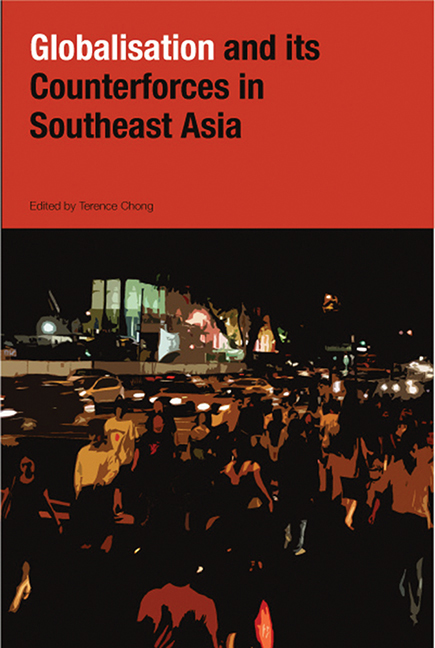Book contents
- Frontmatter
- Contents
- Foreword
- Preface
- The Contributors
- Introduction
- Part I The Political Contradictions of Globalization
- Part II Economic Regionalism and Global Influences
- Part III Local Security, Global Insecurity
- Part IV Social Processes: Arrested Development
- Part V Cultural Production in the Global Matrix
- 15 Measuring Cultural Globalization in Southeast Asia
- 16 The Singaporean Creative Suburb of Perth: Rethinking Cultural Globalization
- 17 Thai Magical Realism and Globalization
- Index
16 - The Singaporean Creative Suburb of Perth: Rethinking Cultural Globalization
from Part V - Cultural Production in the Global Matrix
Published online by Cambridge University Press: 21 October 2015
- Frontmatter
- Contents
- Foreword
- Preface
- The Contributors
- Introduction
- Part I The Political Contradictions of Globalization
- Part II Economic Regionalism and Global Influences
- Part III Local Security, Global Insecurity
- Part IV Social Processes: Arrested Development
- Part V Cultural Production in the Global Matrix
- 15 Measuring Cultural Globalization in Southeast Asia
- 16 The Singaporean Creative Suburb of Perth: Rethinking Cultural Globalization
- 17 Thai Magical Realism and Globalization
- Index
Summary
INTRODUCTION: GLOBALIZING SINGAPORE
It is important to realise that cultural globalisation is no longer conceptualised in terms of the emergence of a homogenised global culture corresponding to Marshall McLuhan's global village. Instead, cultural globalisation is recognised as a complex and diverse phenomenon consisting of global cultures originating from many different nations and regions.
Globalisation has greatly expanded the means by which migrants can remain actively involved in the economic, cultural, social and political life of sending countries. Financial remittances, internet communications and travel, diaspora and hometown associations, and other mechanisms for expatriates to reside abroad and maintain ties with their country of origin are today creating powerful tools for development.
Singapore was declared the most globalized economy in 2000 by U.S.-consultancy firm AT Kearney in conjunction with American thinktank magazine Foreign Policy. The AT Kearney/Foreign Policy Globalization which evaluates levels of global integration in a wide selection of advanced economies and emerging markets worldwide, was created to quantify has arguably become a buzzword of the twenty-first century. The four broad indicators used to measure globalization range from technological connectedness, political engagement, trade and economic integration to the extent of personal contact across borders. Singapore received the highest accolade in 2000 — a position it regained in 2004 after losing the top spot to Ireland for three consecutive years from 2001 to 2003 inclusive — due primarily to its willingness to embrace a more open economy, its nimbleness in economic and financial policies, as well as its advances and versatility in information and communication technologies (ICTs).
Although new variables have been added to the Globalization Index since 2001 to improve the accuracy of collectable data, one aspect of globalization remains unaccounted for, that is, culture or, indeed, cultural globalization. As AT Kearney revealed in its 2002 report:
Cultural exchange has undoubtedly grown in tandem with the movement of people and ideas across borders and with the growing use of communications technology, but little accurate data are available.[…]
- Type
- Chapter
- Information
- Globalization and its Counter-Forces in Southeast Asia , pp. 359 - 379Publisher: ISEAS–Yusof Ishak InstitutePrint publication year: 2008

